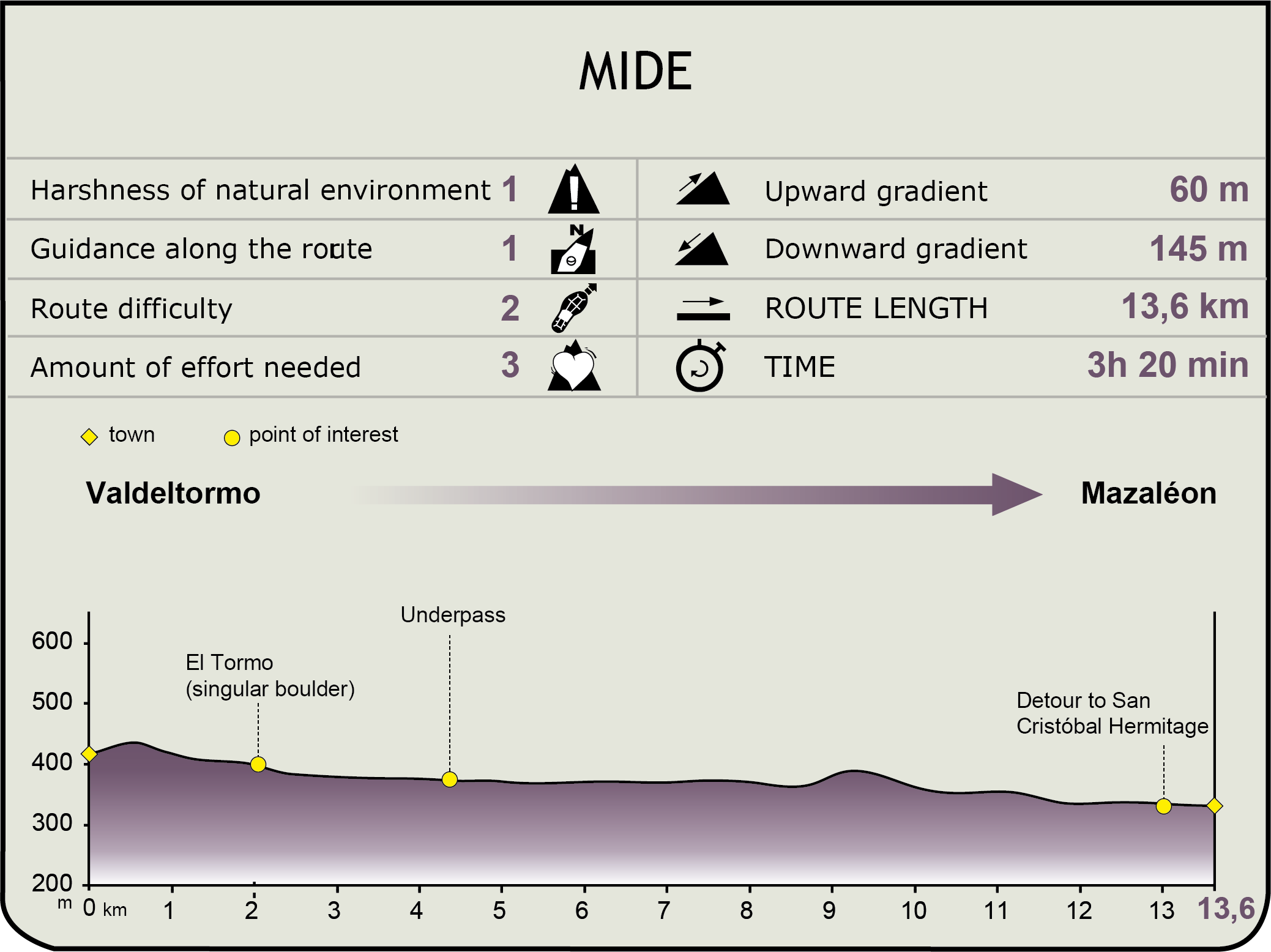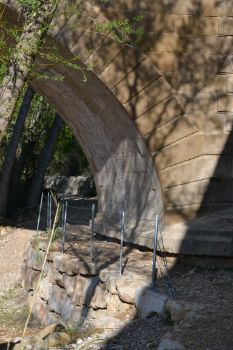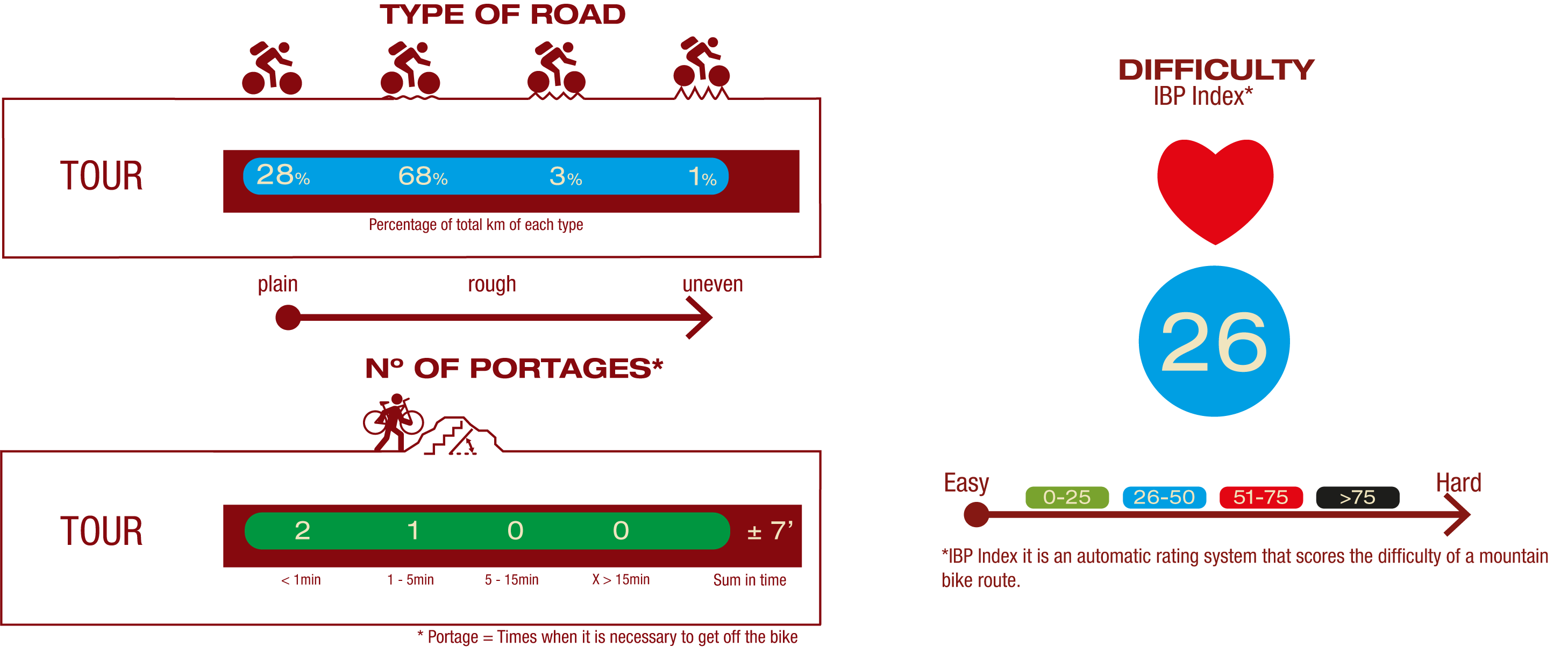Net of Natural
Trails

Stage 5. Valdeltormo-Mazaleón
Description
Back to the right bank of Matarraña River towards Mazaleón and the hermitage of San Cristobal
The fifth stage of this trail takes the traveller back to the right bank of the Matarraña river, following its course towards the town of Mazaleón among crops, pines and olive trees. Before reaching this town, there is a branch allowing the traveller to go up to the hermitage of San Cristóbal, where stunning views over the region can be admired.

During the first kilometres of this stage, the traveller must go back to the fourth stage, to the Tormo rock. From there, the traveller must take a path on the left that crosses the Matarraña river using a platform and a ford, both of them of concrete. When the river carries a lot of water, it is more difficult for travellers to cross the latter.
After crossing the river, the traveller must take the path on the left, going between the river (on the left) and fruit crops (on the right), until the TE-V-3001 road is reached. The trail then turns left before reaching the road, going under two bridges over the river, with footbridges linking their pillars helping travellers to cross. On the other side of the bridges, there is an irrigation canal that accompanies the trail for some metres and will keep reappearing along the stage from time to time.

Having passed by a pine stand on the left, the trail runs quite high over the course of the river for a stretch, so the traveller must be cautious (walking close to the right side of the path should be enough). The landscape is the same as in previous stages: crops in the meadows, and pine and olive tree forests on the right. Along this stretch, the traveller goes through paths giving access to private properties. Intersections are well-indicated, but the travellers must still pay attention. One of these intersections is used to get to the town of Calaceite, which has a relevant historical heritage, such as the Iberian archaeological sites in the village of San Antonio and the one in Tossal Redó.
The trail goes near the river again, as the olive trees replace the pine forests. This announces the proximity of the town of Mazaleón, which is the next stop in this natural trail. In order to enter this town, the traveller must leave the bridge over the Matarraña aside and take the footbridge located a few hundred metres ahead, where a stretch shared with the following stage leads to the entrance to Mazaleón.
Branch towards the hermitage of San Cristóbal

Before crossing the river, there is a branch allowing the traveller to go up to the hermitage of San Cristóbal through a steep slope that turns sharply to the left and continues through a Way of the Cross leading to the hermitage door. Besides enjoying the amazing views from this promontory, the traveller can visit the Iberian archaeological site of San Cristóbal and the “Route of the Iberians” Visitor Centre about the origins of the Iberian culture. The centre is located near the hermitage.
Managing Entities
Sites of interest
Puntos de interés
Culture
- Piuró del Barranc Fondo
- Ermita de San Cristóbal (Calaceite)
- Poblado ibérico de San Antonio
- Poblado ibérico de San Cristóbal
- Iglesia de Santa María la Mayor
- Poblado ibérico Escondines Altos y Bajos
- Iglesia de Nuestra Señora de la Asunción
- Poblado ibérico Tossal Redó
- Ermita de San Cristóbal (Mazaleón)
Geology
Hydrography
Information
Infrastructure
Municipality
Hostel
Vegetation
Profile

(Calculated according to the MIDE criteria for an average excursionist with a light load)
Highlights
Further information
Valdeltormo
This town is named after the Tormo rock, a particular rock formation sculpted by the Matarraña river. The most remarkable building in this town is the old City Council. Its market, still preserved today, is a witness to the most important decisions made in the town over the centuries. Opposite this building, the traveller can see the parochial church of La Asunción de Nuestra Señora, from the 17th century. It is a Baroque building with a rectangular floor plan, and its main façade stands out due to its tower and its simple portal. In this town, the traveller can also visit the “Route of the Iberians in Lower Aragon” Visitor Centre, about the Iberian architecture and aristocracy.
Calaceite
From this stage of the nature trail, the traveller can take the branch leading to the town of Calaceite, about 5.5 km away.
Its old town was declared Site of Historical-Artistic Interest in 1973. This town was built around its Plaza Mayor, from where the three main streets depart, linking with the gates-chapels of the Virgen del Pilar, San Antonio and the Virgen del Rosario. The City Council, also located at the Plaza Mayor, stands out due to its mannerist façade and its beautiful market. The traveller can also visit the church of La Asunción, which has a Baroque façade and a bell tower. The Juan Cabré Museum, about this archaeologist who was born in this town, is also worth visiting. It has an important collection of Iberian votive offerings, as well as temporary art exhibitions.
There are several remains of the Iberian era in this town. One of the most relevant is the village of San Antonio, next to the namesake hermitage. Also in the town, but further from the town centre, lays the archaeological site of Tossal Redó.
Multimedia
Downloads
GPS Downloads
Documents
Cyclability
TYPE OF ROAD, PORTAGES & DIFFICULTY
SAFETY RECCOMENDATIONS
- Sections shared with hikers.
- Transit through the centre of some population centres.
- Due to the fact that the route runs close to riverbeds, crossing them on several occasions, you are informed that there may be seasonal discontinuities caused by floods, increases in flow, floods or transit through flood-prone areas.
GENERAL RECOMMENDATIONS
- Find out about the technical aspects of the route and the weather on the day.
- Take care of the environment. Take care not to disturb animals or damage vegetation. Respect private areas.
- You must give priority to pedestrians and comply with general traffic rules.
- The environment in which you will be riding is open, free to move around and an area where many activities are carried out (sporting, forestry, livestock and agricultural activities). Always have an understanding, prudent, responsible and respectful attitude.






